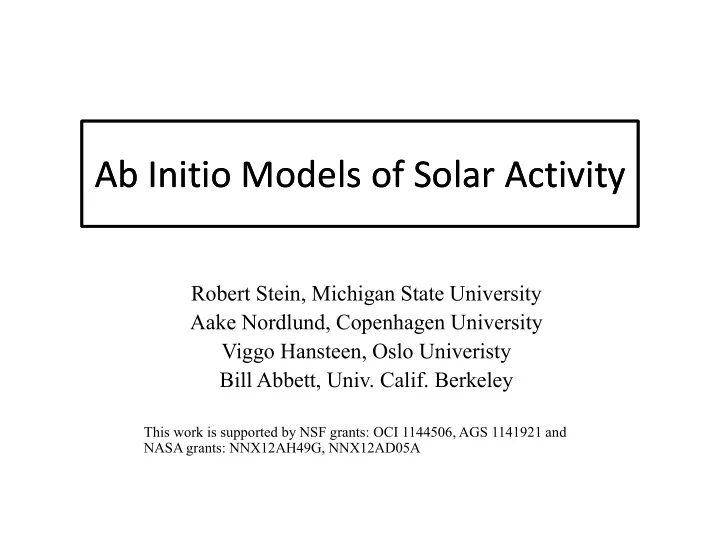

Ab Initio Models of Solar Activity Ab Initio Models of Solar Activity Robert Stein, Michigan State University Aake Nordlund, Copenhagen University Viggo Hansteen, Oslo Univeristy Bill Abbett, Univ. Calif. Berkeley This work is supported by NSF grants: OCI 1144506, AGS 1141921 and NASA grants: NNX12AH49G, NNX12AD05A
Solar Explosions: CMEs
GOAL: Understand Active Regions • Magnetic fields are generated by dynamo action in solar convection zone • Fields erupt through the visible solar surface to produce pores, sunspots and active regions • New field interacts with existing field in the atmosphere to store and release magnetic energy which produces the explosions Method: magneto ‐ radiation ‐ hydrodynamic simulations
Challenge • Physics o Excitation and Ionization o Radiation energy transport o Turbulence • Spatial & Temporal Range o DKIST will resolve 30 km o Convective structures 1 ‐ 100 Mm o Surface convection – minutes, deep convection ‐ days
Magneto ‐ Hydrodynamic Equations • Mass conservation / t = − ∙ ( u ) • Momentum conservation ( u )/ t = − ∙ ( uu ) − − g + J × B − 2 Ω × u − ∙ visc • Energy conservation visc + J 2 / t = − ∙ ( u ) − ( ∙ u )+ rad + • Induction equation & Ohms law B / t = − × E, E = − u × B + J + (1/en e ) ( J × B − e ), 5
• Spatial differencing Numerical Method – 6 th ‐ order centered finite difference. • Time advancement – 3 rd order, Runga ‐ Kutta • Equation of state – tabular – including ionization – H, He + abundant elements • Radiative transfer – 3D, LTE – 4 bin opacity distribution function • Diffusion f f t x i x j diffisusion 3 / max f 2, 1,0, 1, 2 ) 1/2 c 2 u i c 3 0 i c 1 ( c sound 2 c Alfven 2 3 u x i
6 th order Finite Differences 5 th order Interpolation b f i 1, j , k f i 2, j , k c f i 2, j , k f i 3, j , k f i 12, j , k a f i , j , k f i 1, j , k where c 3/ 256, b 25/ 256, a 0.5 b c 7
Key Challenge: Radiation Transport • Radiation transport is inherently 3D & non- local. It couples distant regions lots of communication. STAGGER uses long characteristics, filling the volume. Need to communicate volume data. • Solution: restrict transfer calculation to only surface layers where it is important for the energy balance. • Restrict number of frequencies (energies) and directions (rays).
Vertical and 4 angled rays One through each surface cell Angled rays rotate each time step, sweep out volume
Multigroup opacity and source function. Bin frequencies according to opacity magnitude. Use 4 bins, need 12 for precise agreement with observations
Boundary Conditions • Vertical: – Density: Top extrapolate ln ρ . Bottom ‐ inflows fix rho, ‐ outflows rho <rho>. – Velocity ‐ > constant @ top, zero derivative @ bottom; – E=energy/mass Top: average value, Bottom: extrapolate <E> outflows, fix E inflows. • B tends to potential field @ top, B advected by Inflows @ bottom (20 Mm) ‐‐ Weak (1 kG) or Strong (5 kG), minimally structured (horizontal, uniform, untwisted) magnetic field . Represents top of larger, rising flux concentration . Imposed via specifying the horizontal electric field. 11
Simulations • Variable is field strength and geometry (controlled by the convection, deeper larger). • Project: ① Extend computational domain from 20 to 30 Mm depth so has larger convective cells and overlaps interior, global dynamo calculations. Use dynamo data spatially and temporally ② varying magnetic boundary condition.
Observed AR Flux Emergence: Vertical Field 13
Simulated Vertical B
Tracking magnetic field lines: Rising Magnetic Loop
Summary • Use BW 32 ‐ 64K nodes to model AR formation by magneto ‐ convection. • Extending domain in depth and width to accommodate realistic solar AR. • Provides synthetic data for improving & validating helioseismic inversions of magnetic regions. • Provides synthetic data for analysis of observations from new solar telescopes: NST, Daniel K. Inouye Solar Telescope (DKIST, formerly ATST) • Other parts of project await completion of extension to 30 Mm depth x 192 Mm width.
Recommend
More recommend